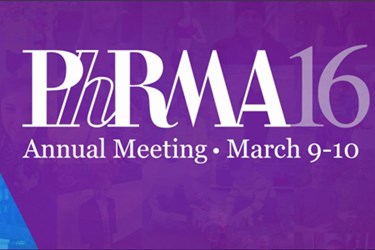How PhRMA Is Adapting To The Industry's New Reality

By Rob Wright, Chief Editor, Life Science Leader
Follow Me On Twitter @RfwrightLSL

PhRMA held its 2016 annual meeting March 9 and 10 in Washington, D.C. This was the first annual meeting held under the new leadership regime of Stephen Ubl. Having spent more than 10 years as the president and CEO of the Advanced Medical Technology Association (AdvaMed), Ubl took the PhRMA helm just three days after former Turing Pharmaceutical CEO Martin Shkreli made national headlines with his drug-price increase antics. And though many (yours truly included) believe Shkreli not to be representative for what the biopharmaceutical industry stands, his actions provided further fuel for an industry being bashed and bullied by media and politicians alike. According to Candy Alt Crowley, former chief political correspondent for CNN and guest speaker at this year’s PhRMA meeting, 72 percent of Americans currently believe that drug prices are too high. Her advice to this year’s gathering — industry need to take its value-and-access messaging to the American people, for that is where the folks on Capitol Hill get their marching orders. This pretty good advice already has been taken by PhRMA’s industry counterpart organization — BIO.
Keep Your Friends Close, And Your Media Closer
For Ubl and PhRMA the stakes have never seemed higher. However, at just six months into his leadership role, already there has been a noticeable difference. For example, last year’s annual meeting was a closed-door affair, a decision of which I was quite critical. This year’s meeting, however, was open by invitation to members of the press — a move I see as a very positive sign. The saying, “Keep your friends close, and your enemies closer” seems to apply for the biopharmaceutical industry when it comes to dealing with the media in today’s politically charged environment.
One idea for how the biopharmaceutical industry can develop a closer relationship with the press came to me during a panel discussion (Innovation: The Future of Medical Discovery) exchange between Jeffrey Flier, M.D., dean of the faculty of medicine at Harvard University, and Joseph Jimenez, CEO, Novartis. Dr. Flier mentioned a Harvard researcher joining the Novartis team. While Flier admitted that having an academic researcher join industry to be a practice typically frowned upon by academia, he pressed Jimenez as to if Novartis would be hiring more Harvard researchers. In reply, Jimenez referenced the scholars in residence program as evidence that Novartis already is. But as Harvard Medical School (HMS) knows, there is benefit beyond just having scientific scholars in residence. For example, one of the unique opportunities HMS provides is a media fellowship. This year the school invited reporters to apply to one of the two programs offered, and will select eight applicants to participate. The fellowships are offered as educational opportunities on a background basis, noting “We do not monitor fellows’ contact with faculty throughout the program.” Perhaps PhRMA could work with its members to develop a similar week-long media immersion experience? From my perspective, to be successful, such an opportunity needs to be much more than a highly choreographed media day or a facility tour. And while some might view this as being too high risk, I would imagine an industry steeped with such a can-do culture is capable of mitigating the risk in order to maximize the reward.
High Risk, High Reward
During Ken Frazier’s welcoming address (video here), the 2016 PhRMA chairman discussed risky propositions that pay off. One of the examples he first drew on was the venue for this year’s meeting, the Washington Marriott Wardman Park. When real estate mogul Harry Wardman announced his plans to build the 1,200-room hotel back in 1918, it was dubbed by Washingtonians as “Wardman’s Folly,” because it was then being built in what was considered the countryside. Yet nearly 100 years later, the facility is surrounded by activity. Just as Wardman had to overcome criticism to realize his vision, so too should biopharma. Frazier referenced two recent examples — Ebola and Zika — that the world is not completely in alignment behind sensational headlines that target industry. According to Frazier, during the recent Zika virus outbreak, just as the Ebola crisis before it, the question that keeps coming up is, “When is there going to be a vaccine?” Frazier went on to recognize a number of industry successes that have revolutionized healthcare saying, “We are literally inventing new ways to cure and treat diseases.” As another example of the power biopharma has to change the world, Frazier referenced the awarding of the 2015 Nobel Prize in medicine to an industry scientist. While the executive admitted to biopharma’s reputation having been tarnished by a few bad actors of late, it is clear that both he and PhRMA are not focused on the past, but the future. That being said, given the current public drug-pricing perception, it is probably best not to ignore the present. For if we want biopharma to be able to achieve future cures, it needs to be rewarded, not penalized, for taking such high risks.
